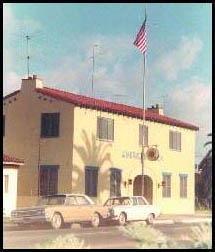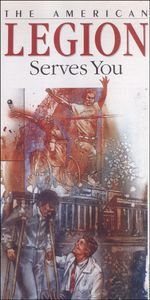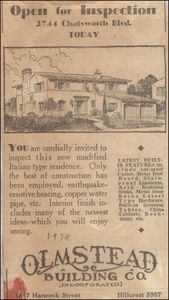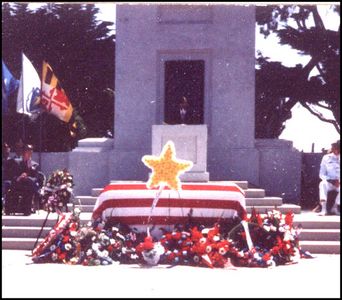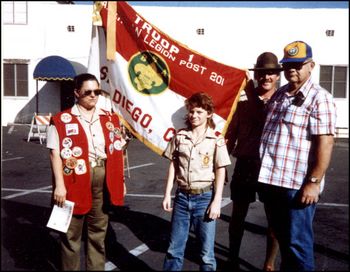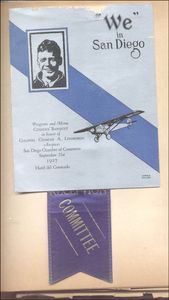|
|
 |
|
|
Historic Landmark No. 525 Historical Landmark No. 525 - Designated June 2002 |
|
|
| ||
|
|
| ||
|
|
Mitchell died in 1926, but bequeathed $10,000 for the creation of the DeWitt C. Mitchell Memorial American Legion Post 201. Olmstead Building Company built the hall under budget and the entire city showed up for opening ceremonies in 1931. The Army from Fort Rosecrans brought searchlights and bands played into the morning hours. Newspapers and radio loved the Legionnaires and important people flocked to the hail for meetings. The dedication drew thousands of citizens, elected officials, judges, and honored dignitaries. For the next 20 years, elected officials held unofficial meetings at the hall to discuss discrete matters and plot political actions for the benefit of the community. The hall also served local churches, arranged weddings, rummage sales, and dances for the East San Diego people. From this cauldron of activity, many Legionnaires tossed their hats in the ring for political office. John Faddis, for example, won a seat on the County Board of Supervisors and fought for veteran’s benefits, the War Memorial Building in Balboa Park, and placement of cannons in local parks. | ||
|
|
| ||
|
|
Olmstead almost grew beyond the DeWitt C. Mitchell Memorial American Legion Post 201, but instead drew the movers and shakers to the hail for unofficial meetings. In turn, the Mayor of San Diego appointed him to the City Parks Commission and his company experienced a “gold rush” of home building. Olmstead further involved the post by creating Boy Scout Troop Number 1 to help reduce juvenile delinquency. He promoted Boy Scout activities by radio announcements and soon connected with Col. Edward Fletcher to build Camp Fletcher for the Boy Scouts at Cuyamaca Mountain in 1930. Scrapbooks held by the Post document how veterans returned from the battlefields of World War I with a mission to improve the quality of life in America. The members of this Post set about to end juvenile delinquency in East San Diego by working with the Police Department to round up hooligans and give them a choice between jail or joining the Boy Scouts. Those battlefield tough Legionnaires became the scoutmasters and soon found themselves organizing baseball teams, campouts, scrap paper and metal drives, working with the Navy to direct traffic, and caring for wounded and sick veterans at the Naval Hospital. This post raised funds for an iron lung, ambulance, and beds donated to an orphanage. When World War II broke out, the Legionnaires, the women’s auxiliary, and their Boy Scouts were first to volunteer. Many of those boys were among the first to enlist and some were the first to die, but all pitched in with the fervor and drive the original Legionnaires envisioned when Post 201 formed in 1922. | ||
|
|
Legionnaires and American Legion Hall Serves Community Olmstead insisted their meetings continue at the hall, as well as church socials, rummage sales, weddings, and other community events. There were many important Legionnaires who served on the board of directors and promoted revitalization of the inner city. They organized the Scouts to help police patrol the neighborhoods, direct traffic, and guard at sports games. Legionnaires and Scouts formed bands, honor guards and even had a women’s drill team called the Kadettes. Through the Great Depression, the hail helped San Diego through tough times. Legionnaire John Faddis and others would springboard from the hall to elected office. | |
|
|
All the synergy of DeWitt C. Mitchell Memorial American Legion Post 201 hit a crescendo just as World War II broke out. The hail had raised money for an iron lung and ambulance and collected tons of magazines for sick and injured members of the Armed Forces recuperating at Naval Hospital. Boy Scout Troop Number 1 sponsored the first enlistees and younger members expanded scrap metal and paper drives, volunteered to help the Navy direct traffic, and sponsored dances. Perhaps those big band dances of World War II provide the most enduring images of DeWitt C. Mitchell Memorial American Legion Post 201 in the minds of local citizens. Those USO parties were all the rage with the movers and shakers of the City of San Diego and all the community looked forward to the hail for community support. | ||
|
|
The De Witt C. Mitchell American Legion Hall Post 201 is associated with important San Diegans such as George W. Marston, Mayor Austin, Mayor Harry Clark, City Attorney John Nolan, Colonel Charles A. Lindbergh, Actor Will Rogers, Chief of Police Clifford E. Peterson, County Supervisor John Faddis, Vice President Walter Wallace, and Colonel Ed Fletcher. The synergy set forth by the American Legion Movement following World War I and civilian Progressive Party politics shaped California and local history governments and civic organizations during the 1920s. These dynamics expanded out to civic programs such as developing parks for the greater community, saving Torrey Pines City Park from Highway 101 development, and creation of a landmark Supreme Court Decision that to this day orients City of San Diego decisions in the use of Pueblo Lands. | ||
|
|
Post Leaders Dominic Frankville, Annabelle Smith , and Commander William Bishop Work for Landmark Status Post Historian Dominic Frankville, Commander William Bishop, Annabelle Smith, and the Legion's directors worked many hours with Legacy 106, Inc. to develop a program to nominate the post to San Diego's register and later the National Register of Historic Properties. Sadly, Frankville died before the second goal could be achieved. By unanimous vote, the City of San Diego's Historical Resources Board declared the DeWitt C. Mitchell Memorial American Legion Post a Historic Landmark on June 27, 2002. The landmark status recognizes the Post's 1922 origins and contributions to the community through the end of the Korean War in 1953. The American Legion Hall building is important because it exemplifies special elements of East San Diego’s historical, cultural, social, economic and political development. It is also important because of the people who were associated with it. The city recognized the contribution of Lester Olmstead, who was a master builder of the 1920s and 1930s. | |
|
|
Permission to use this material is granted provided it is attributed as follows: Copyright © 2010 Ronald V. May and Dale Ballou May, Legacy 106, Inc., www.legacy106.com | |
|
|
Home | Designations | Qualifications | Company Profile | Newsletter | Links Archaeology
& Historic Preservation www.legacy106.com |
|

